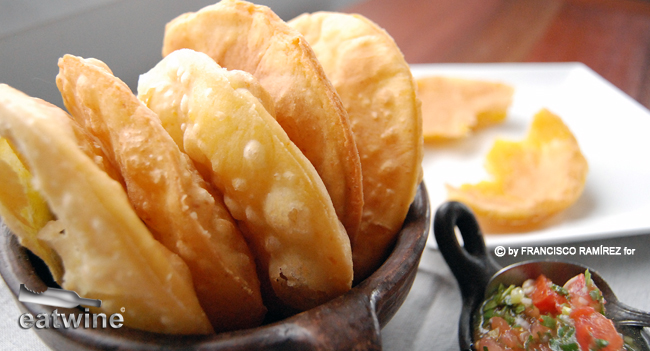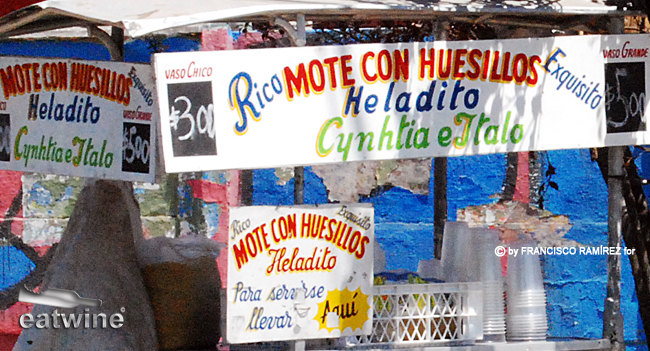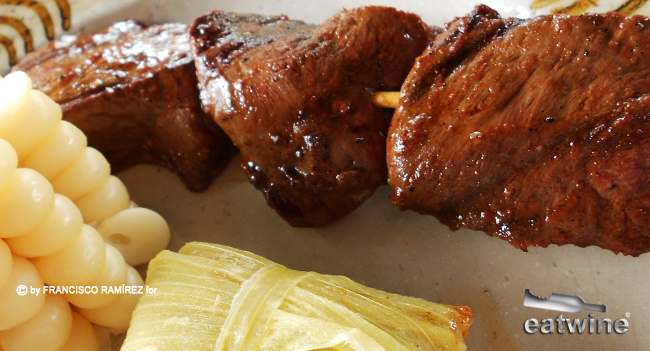One of the things that I most love about living in South America is the street food. Those roadside stands, the market tables, and the hawkers are such a huge part of the eating experience here. Here’s my short list of my favorite street foods from Peru, Chile, Argentina, Uruguay, and Brazil. Go to a place recommended by someone’s who food opinion you trust, or use common sense as to the cleanliness of the vendor and freshness of the food, which can never hide. Just writing this post is making me hungry.
Chile
On any given morning at La Vega you’ll see a crowd of people gathered around stands where short women, roll out orange-colored dough into disks. Tossed into hot oil, they float to the top in the bubbling oil and handed to you on a skewer. This, my friends, is Chile’s favorite street food called sopaipillas. Fleshy orange pumpkin (always savory, never sweet) is cooked, mashed, and needed into the dough for a delicious, fluffy, savory taste. How do they like it? Laced with racy pebre, chili sauce tinged with cilantro and onions.
Many corners are makeshift restaurants pumping out colossial sandwiches and the ubiquitous completos, hot dogs with the works. Take one skinny hot dog, plus a bun, and see how much chopped tomato (1/2 cup), mashed avocado (2/3 cup), and mayo (1/4 cup) it can possibly hold without falling apart under its own weight. Then, try to eat it—gracefully. These babies are, for a reason, the much-beloved post-partying food.
During warm weather, Chileans have an internal thermometer that soars with the mercury in the afternoon. They don’t reach for Iced Tea or Lemonade here. No, no, no. Head out into the downtown area and carritos hawking mote con huesillo are on just about every corner. It’s the ice cold juice made from sundried peaches that make this drink magic.
Peru
Peruvian street food always feels like a party since there’s so much flavor happening in every bite. Anticuchos are arguably a gastronomic subculture throughout the country where people line up in the early evening to sink their teeth into tender, rich beef heart marinated in the most umami-licious concoction of flavors your palate could every imagine. And grilled over open flames. So. Damn. Good. If you’re a vegetarian, I am really sorry because this is one of those food rites of passage in Peru where there’s a clear before and after.
A close second favorite of mine are tamales. Always made fresh in the morning, the vendors (usually women) sit tucked away in corners selling these steamed, hot treasures (all made with fresh, non GMO Peruvian corn). They sell out like hot cakes. There are two types—salado or dulce. The savory version has chili, onions, a bit of meat, and an olive while the sweet one has raisins. Why they don’t have whole bakeries making these abroad yet is beyond me. I am totally addicted to them.

While I could go on about ceviche, a given in Lima and most of the country, most curious is that in the highlands, or La Sierra, locals l-o-v-e to snack on hard-boiled quail’s eggs. It’s not uncommon in the Sacred Valley to see vendors shelling quail’s eggs and selling six of them for a sole (about US$.30).
Brazil
The last time I spent a day on Ipanema beach in Río de Janeiro, many moons ago, I marveled at how everything I needed in life magically appeared on my canga, Brazilian beach towel. Forget your SPF? No problem. Stepped on your sunnies (shitttt!)? Check out 100 designer knock-offs. Hungry? Why, yes. Very. How about some skewers of juicy, just-off-the-grill camarão (shrimp) with an ice-cold beer and touch of lime. Now these guys are really reading my mind.
Beyond the beaches, I became enchanted by pastéis, a form of the empanada brought to Brazil by the Portugese. I have brilliant memories of walking through the Saturday market in Jardins (São Paulo) to stop at a stand pumping out the crunchiest, most delicious ones ever I have had tasted. The secret? The fry-master swore that the touch of cachaça, a local firewater, in the dough made it crisp–it does, tested in our cookbook. The crunchy outside encased dynamo fillings like shredded chicken breast with gooey catupiry cheese, or prawns with a touch of spice and chunks of tender palm hearts.
In northern Brazil, particularly the state of Bahia, aracajé was brought by with the slaves from Western Africa, sold on the streets of Bahia by freed female slaves. This bean cake is a mixture of mashed black-eyed beans, onions and shrimp fried in dendê (palm oil). Palm oil, amigos, is not for the faint of heart. It’s incredibly aromatic, heavy on your stomach, and artery blocking. Let’s suppose you’ve thrown health precautions to the wind and want to eat it following local custom. Have the baiana de aracajé dress your bean cake with spicy, shrimpy pastes, like vatapá and caruru, after it’s been halved. Top it off with a crunchy, fresh salad.
Uruguay
Wandering the streets of Montevideo (and in all fairness, other South American capitals), you suddenly sense a perfume of nutty, caramel-laden goodness. Where is that coming from?? On the corner, you see a guy doing magic in a copper pot as sugar is transformed into caramel. Roasted peanuts are gently coated as he tosses them with a mesmerizing, efficient movement. Once cooled, garrapiñada turns into little bites of love. They really hit all the right notes you crave in a snack: crunchy, toasty, sweet, salty in each tiny bite.
Also inherited from the Spanish is the love for churros, the European equivalent of a long, tubular doughnut. Churros wagons show up in many parks (where there are kids, of course), typically stuffed with dulce de leche or dusted with cinnamon-sugar. Or take them home and try dipping them in your hot chocolate.
Empanadas may not be original to Montevideo, they’re prolific throughout South America, but there’s one stop that’s a must when you’re in Cuidad Vieja. El Rincón, on the corner of Rincón and Zabala, specializes in 15 flavors of empanadas with decidedly Uruguayan flavors. Try the ham with hearts of palm and salsa golf (mayo with ketchup), this unusual sauce that people go crazy over. How about the capresse with artisan mozzarella, fresh tomato and albahaca, a nod to the heavy Italian heritage? All baked, by the way.
Argentina
Argentina and Uruguay have a lot of overlap in some street foods like the above-said garrapiñada and empanadas. However, when in Argentina, meat is king. Understandably, there are stands offering a parrilla, full grill, for the working folks of the city who don’t have time to stop for lunch or go light up the grill. Porteños love to down choripan (sausage sandwich) and vacipan (flank steak sandwich) straight off the flames. Or try an on-the-go, milanesa, a bread-coated, crunchy steak stuffed in a roll. Dose any of the above options with copious amounts of chimichurri and salsa criolla to hit multiple pleasure centers.
Often, while not technically street food since sold in joints, a slice of Buenos Aires-style pizza like fugazza, a type of pizza made without tomato sauce and topped with onions; or fainá, a flat bread made with garbanzo flour are favorite snacks.
Have fun exploring!















